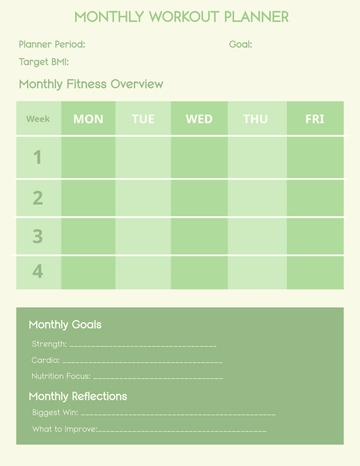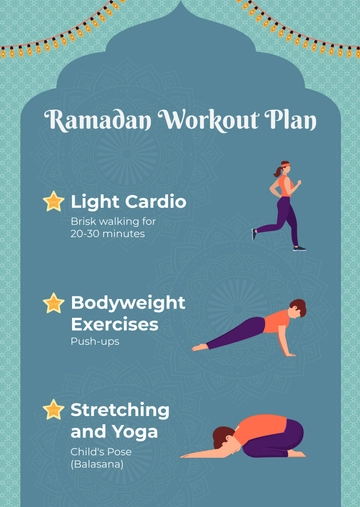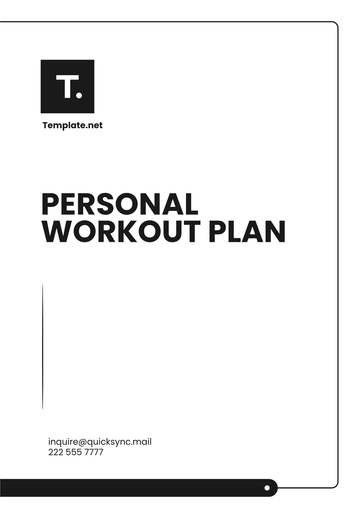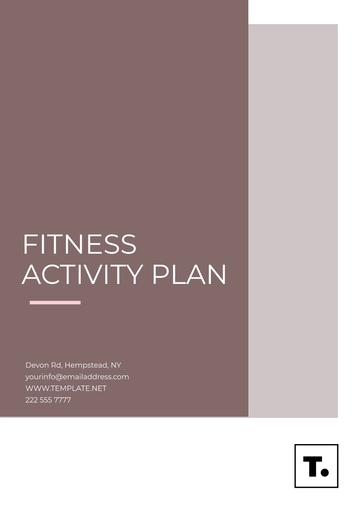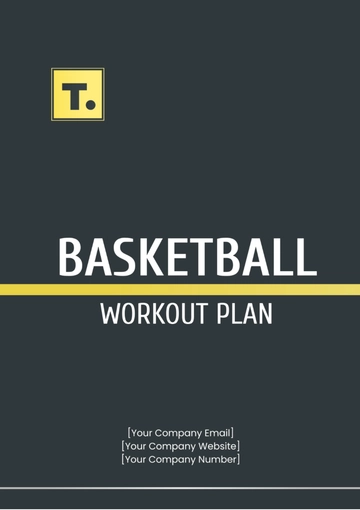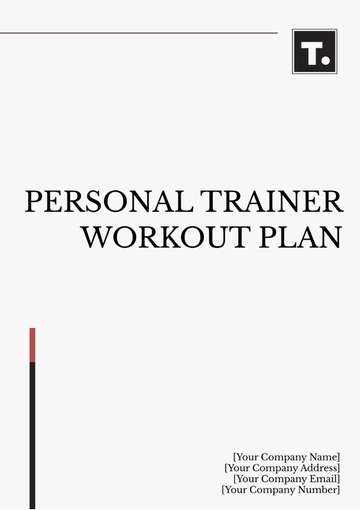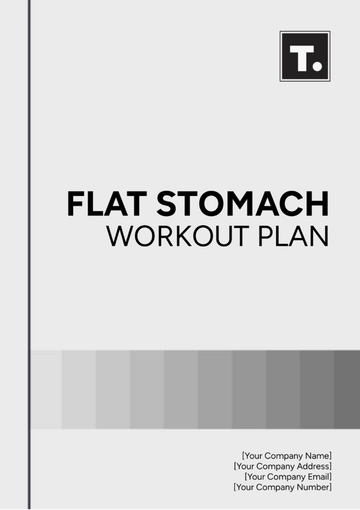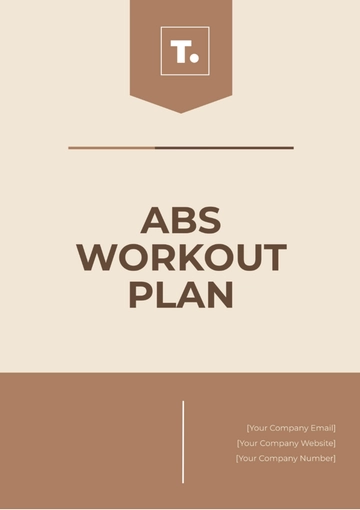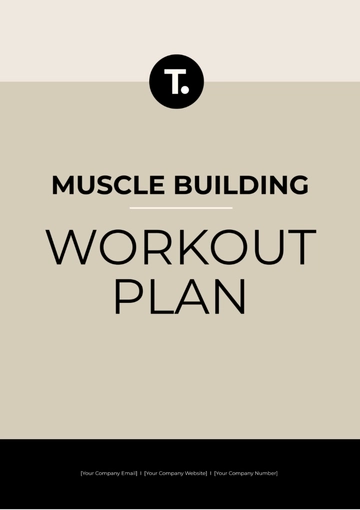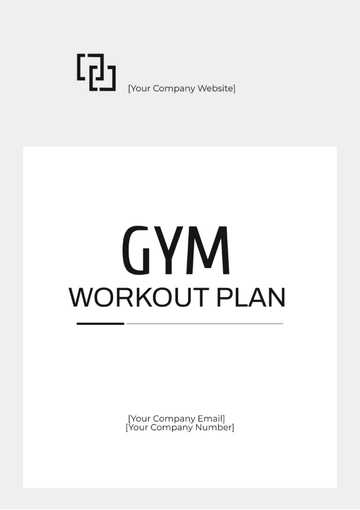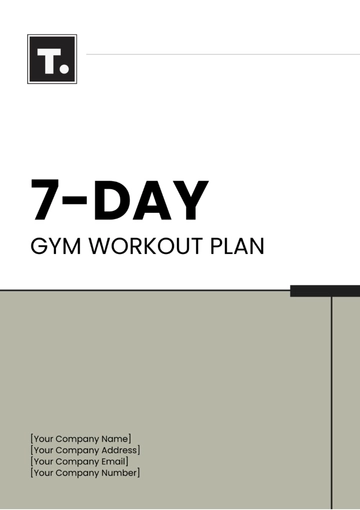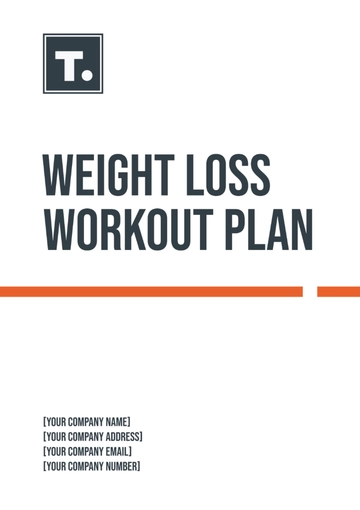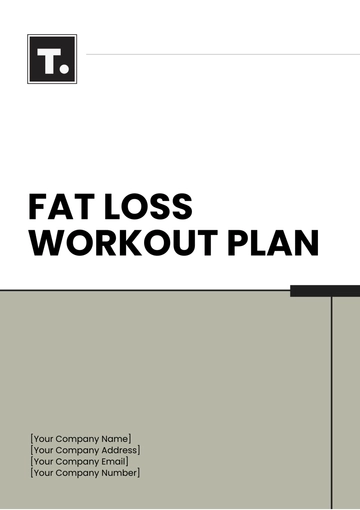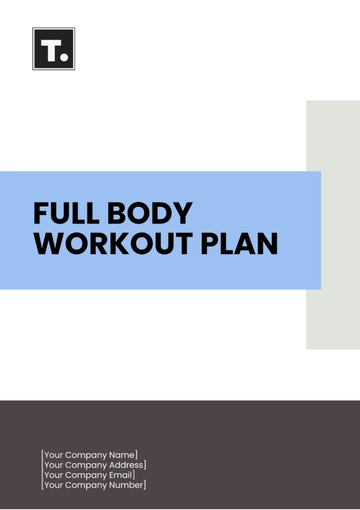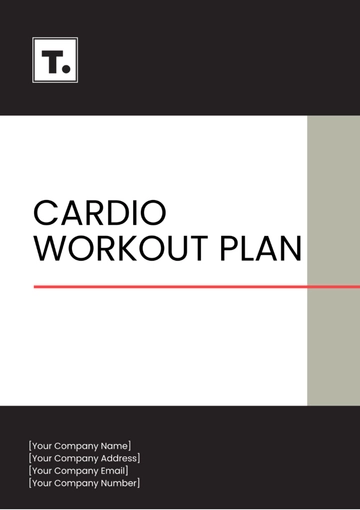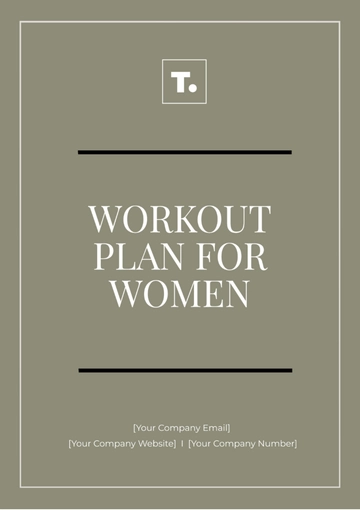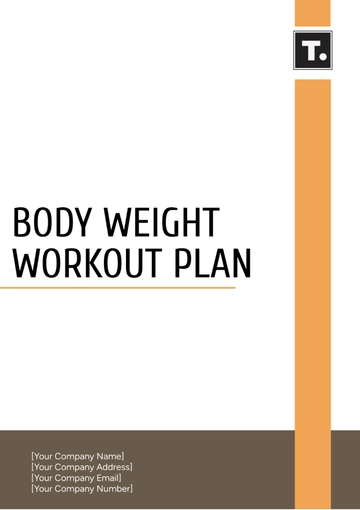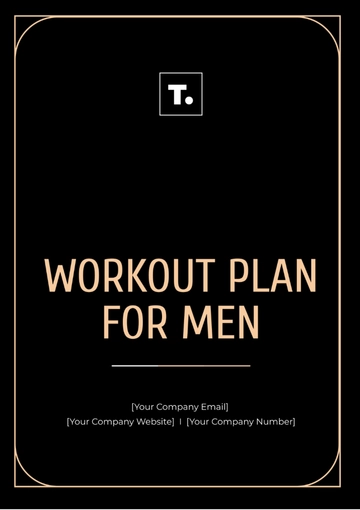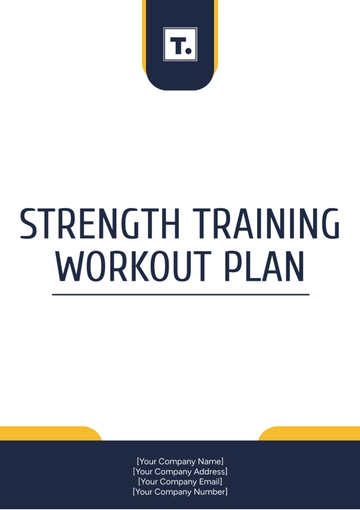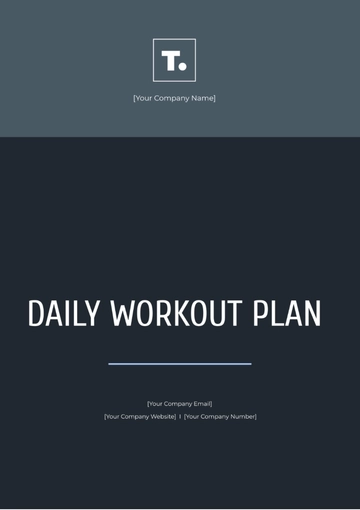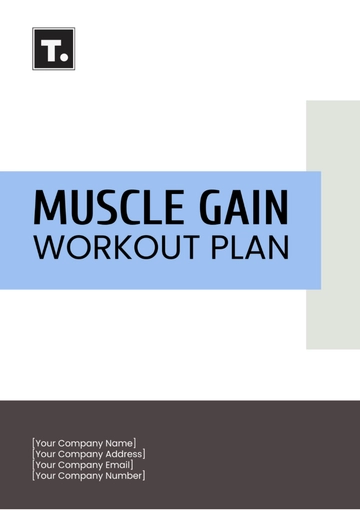Free Gym Weight Lifting Plan

I. Executive Summary
This Weight Lifting Plan of [Your Company Name] is designed to help clients achieve their strength and fitness goals through a structured and comprehensive weight lifting program. This plan outlines various routines, techniques, and strategies to maximize muscle gain, improve strength, and enhance overall physical health. By following this plan, clients can expect to see measurable progress in their lifting capabilities and overall fitness levels.
This document details the different phases of the weight lifting plan, including beginner, intermediate, and advanced routines. Each phase is tailored to accommodate the specific needs and fitness levels of clients, ensuring that they receive appropriate guidance and support throughout their fitness journey. The plan also includes nutritional guidelines and recovery strategies to complement the weight lifting routines and promote optimal results.
The goal of this weight lifting plan is to provide clients with a clear and actionable roadmap to achieve their fitness objectives. By incorporating scientifically-backed exercises, progressive overload principles, and individualized adjustments, this plan ensures that clients can safely and effectively improve their strength and physique.
II. Program Structure
The following table outlines the overall structure of the plan, including the different phases and their respective focuses. Each phase builds upon the previous one to ensure continuous progress and adaptation:
Phase | Duration | Focus | Key Exercises |
|---|---|---|---|
Beginner | 8 weeks | Basic strength and technique | Squats, Deadlifts, Bench Press, Rows |
Intermediate | 12 weeks | Hypertrophy and strength endurance | Squats, Deadlifts, Bench Press, Pull-Ups |
Advanced | 16 weeks | Maximum strength and power | Squats, Deadlifts, Bench Press, Olympic Lifts |
A. Beginner Phase
Introduction to Weight Lifting: Introduce clients to basic weight lifting techniques and safety protocols. This includes proper form, breathing techniques, and the importance of warm-ups.
Basic Strength Training: Focus on building foundational strength through compound exercises such as squats, deadlifts, and bench presses. Emphasize correct form and controlled movements.
Progressive Overload: Implement a progressive overload strategy by gradually increasing the weight lifted. This helps in building muscle mass and strength over time.
B. Intermediate Phase
Hypertrophy Training: Introduce hypertrophy-focused workouts aimed at increasing muscle size. This includes higher volume and moderate intensity exercises.
Strength Endurance: Incorporate strength endurance routines that improve muscular endurance and stamina. This involves higher repetitions and shorter rest periods.
Accessory Exercises: Add accessory exercises to target specific muscle groups and address any weaknesses. This helps in achieving a balanced and well-rounded physique.
Increased Intensity: Gradually increase the intensity of workouts by adding more weight and incorporating advanced lifting techniques.
C. Advanced Phase
Maximal Strength Training: Focus on lifting heavier weights with lower repetitions to build maximal strength. This includes heavy compound lifts and low repetition sets.
Power Training: Introduce power training exercises such as Olympic lifts to improve explosive strength and power. This involves dynamic movements and high-intensity workouts.
Periodization: Implement periodization techniques to vary the intensity and volume of workouts. This helps in avoiding plateaus and ensuring continuous progress.
Advanced Techniques: Incorporate advanced lifting techniques such as drop sets, supersets, and rest-pause sets to further challenge the muscles and stimulate growth.
III. Exercise Selection
The following table lists the key exercises included in the plan, categorized by muscle group. Each exercise is chosen for its effectiveness in targeting specific muscles and promoting overall strength and muscle growth:
Muscle Group | Key Exercises |
|---|---|
Legs | Squats, Lunges, Leg Press, Deadlifts |
Back | Deadlifts, Pull-Ups, Rows, Lat Pulldowns |
Chest | Bench Press, Incline Press, Flyes |
Shoulders | Overhead Press, Lateral Raises, Shrugs |
Arms | Bicep Curls, Tricep Extensions, Dips |
A. Legs
Squats: Squats are a fundamental leg exercise that targets the quadriceps, hamstrings, and glutes. They are essential for building lower body strength and stability.
Lunges: Lunges help in strengthening the quadriceps, hamstrings, and glutes while improving balance and coordination.
Leg Press: The leg press machine allows for a controlled movement to target the quadriceps and hamstrings, providing a safe way to lift heavy weights.
Deadlifts: Deadlifts are a compound exercise that targets the entire posterior chain, including the hamstrings, glutes, and lower back.
B. Back
Deadlifts: In addition to working the legs, deadlifts are excellent for building back strength, particularly in the lower back and traps.
Pull-Ups: Pull-ups target the latissimus dorsi, biceps, and upper back, helping in building upper body strength and width.
Rows: Rows, including barbell rows and dumbbell rows, focus on the middle back and rhomboids, improving back thickness and strength.
Lat Pulldowns: Lat pulldowns are an alternative to pull-ups, targeting the lats and helping in building upper back strength.
C. Chest
Bench Press: The bench press is a primary chest exercise that targets the pectoral muscles, triceps, and shoulders. It is essential for building upper body strength.
Incline Press: Incline presses focus on the upper chest, providing a balanced development of the pectoral muscles.
Flyes: Flyes target the pectoral muscles through a wide range of motion, helping in developing chest width and definition.
D. Shoulders
Overhead Press: The overhead press is a compound shoulder exercise that targets the deltoids, triceps, and upper chest, building overall shoulder strength.
Lateral Raises: Lateral raises isolate the lateral deltoids, helping in building shoulder width and definition.
Shrugs: Shrugs target the trapezius muscles, contributing to upper back and shoulder development.
E. Arms
Bicep Curls: Bicep curls are an isolation exercise that targets the biceps, helping in building arm size and strength.
Tricep Extensions: Tricep extensions focus on the triceps, aiding in arm development and overall upper body strength.
Dips: Dips target the triceps, chest, and shoulders, providing a compound movement for upper body strength.
IV. Training Split
The following table outlines a sample training split for the plan, showing how different muscle groups are targeted throughout the week. This split ensures balanced development and adequate recovery:
Day | Muscle Groups | Key Exercises |
|---|---|---|
Monday | Chest and Triceps | Bench Press, Incline Press, Flyes, Dips |
Tuesday | Back and Biceps | Deadlifts, Pull-Ups, Rows, Bicep Curls |
Wednesday | Legs | Squats, Lunges, Leg Press, Deadlifts |
Thursday | Shoulders | Overhead Press, Lateral Raises, Shrugs |
Friday | Full Body | Compound Lifts (Squats, Deadlifts, Bench Press) |
Saturday | Rest or Active Recovery | Light Cardio, Stretching, Foam Rolling |
Sunday | Rest |
A. Chest and Triceps
Bench Press: Perform 3-4 sets of 8-12 repetitions. Focus on controlled movements and proper form to maximize chest activation.
Incline Press: Perform 3-4 sets of 8-12 repetitions. This exercise targets the upper chest and complements the bench press.
Flyes: Perform 3-4 sets of 10-15 repetitions. Use a moderate weight to ensure a full range of motion and muscle stretch.
Dips: Perform 3-4 sets of 8-12 repetitions. Focus on keeping the body upright to target the triceps effectively.
B. Back and Biceps
Deadlifts: Perform 3-4 sets of 6-10 repetitions. Focus on maintaining a flat back and engaging the posterior chain.
Pull-Ups: Perform 3-4 sets to failure. Use a full range of motion and controlled movements to maximize lat activation.
Rows: Perform 3-4 sets of 8-12 repetitions. Focus on squeezing the shoulder blades together at the top of the movement.
Bicep Curls: Perform 3-4 sets of 10-15 repetitions. Use a controlled tempo to maximize bicep engagement.
C. Legs
Squats: Perform 3-4 sets of 8-12 repetitions. Focus on depth and proper form to maximize leg activation.
Lunges: Perform 3-4 sets of 10-15 repetitions per leg. Ensure balance and stability throughout the movement.
Leg Press: Perform 3-4 sets of 8-12 repetitions. Adjust the foot position to target different parts of the legs.
Deadlifts: Perform 3-4 sets of 6-10 repetitions. Focus on engaging the hamstrings and glutes.
D. Shoulders
Overhead Press: Perform 3-4 sets of 8-12 repetitions. Use a controlled tempo to maximize shoulder activation.
Lateral Raises: Perform 3-4 sets of 10-15 repetitions. Focus on isolating the lateral deltoids.
Shrugs: Perform 3-4 sets of 10-15 repetitions. Use a heavy weight to target the trapezius muscles effectively.
E. Full Body
Squats: Perform 3-4 sets of 8-12 repetitions. Focus on compound movements to engage multiple muscle groups.
Deadlifts: Perform 3-4 sets of 6-10 repetitions. Emphasize proper form and controlled movements.
Bench Press: Perform 3-4 sets of 8-12 repetitions. Use a moderate weight to ensure muscle engagement and avoid injury.
V. Nutrition Guidelines
Proper nutrition is crucial for muscle growth, recovery, and overall performance. The following table presents the recommended macronutrient distribution for clients following the plan:
Macronutrient | % of Total Calories | Key Sources |
|---|---|---|
Protein | 30-35% | Chicken, Fish, Eggs, Legumes |
Carbohydrates | 45-50% | Whole Grains, Fruits, Vegetables |
Fats | 20-25% | Nuts, Seeds, Avocado, Olive Oil |
A. Protein
Daily Intake: Aim to consume 1.6-2.2 grams of protein per kilogram of body weight. This supports muscle repair and growth.
Sources: Include a variety of protein sources such as chicken, fish, eggs, and legumes. This ensures a balanced intake of essential amino acids.
Timing: Distribute protein intake evenly throughout the day, including after workouts. This maximizes muscle protein synthesis.
B. Carbohydrates
Energy Source: Carbohydrates are the primary energy source for weight lifting. Ensure an adequate intake to fuel workouts and promote recovery.
Complex Carbs: Focus on complex carbohydrates such as whole grains, fruits, and vegetables. These provide sustained energy and essential nutrients.
Pre-Workout Nutrition: Consume carbohydrates before workouts to ensure sufficient energy levels. This can enhance performance and endurance.
C. Fats
Healthy Fats: Include healthy fats in the diet, such as nuts, seeds, avocado, and olive oil. These support overall health and hormone production.
Moderate Intake: Maintain a moderate fat intake of 20-25% of total calories. This provides energy and supports nutrient absorption without excess calorie intake.
Balanced Diet: Ensure a balanced diet that includes all macronutrients. This promotes overall health and optimal performance.
VI. Recovery Strategies
Proper recovery is essential for muscle repair, growth, and preventing injury. The following table outlines the key recovery strategies for clients following the plan:
Strategy | Description |
|---|---|
Rest Days | Scheduled days off from training |
Sleep | 7-9 hours of quality sleep per night |
Hydration | Adequate fluid intake |
Stretching | Post-workout stretching routines |
A. Rest Days
Scheduled Rest: Include at least 1-2 rest days per week to allow the body to recover. This helps in preventing overtraining and reducing the risk of injury.
Active Recovery: On rest days, engage in light activities such as walking or yoga. This promotes blood flow and aids in recovery without straining the muscles.
Listen to the Body: Pay attention to signs of fatigue and soreness. Adjust the training schedule as needed to ensure adequate recovery.
B. Sleep
Quality Sleep: Aim for 7-9 hours of quality sleep per night. This is crucial for muscle recovery, hormone regulation, and overall health.
Sleep Routine: Establish a regular sleep routine by going to bed and waking up at the same time each day. This helps in maintaining a consistent sleep pattern.
Sleep Environment: Create a conducive sleep environment by keeping the bedroom cool, dark, and quiet. This promotes restful sleep and recovery.
C. Hydration
Fluid Intake: Ensure adequate fluid intake throughout the day, especially before, during, and after workouts. This helps in maintaining hydration and preventing fatigue.
Electrolytes: Include electrolyte-rich beverages if engaging in intense workouts or sweating heavily. This helps in maintaining electrolyte balance.
Hydration Habits: Develop good hydration habits by carrying a water bottle and drinking regularly. This supports overall health and performance.
D. Stretching
Post-Workout: Include post-workout stretching routines to improve flexibility and reduce muscle soreness. This helps in enhancing recovery and preventing injury.
Targeted Stretches: Focus on stretching the muscle groups that were worked during the training session. This promotes blood flow and muscle relaxation.
Consistency: Make stretching a consistent part of the workout routine. This supports overall flexibility and mobility.
VII. Supplementation
Supplements can support nutritional intake, recovery, and performance. The following table highlights the recommended supplements for clients following the plan:
Supplement | Purpose | Key Benefits |
|---|---|---|
Protein Powder | Increase protein intake | Supports muscle growth and recovery |
Creatine | Enhance strength and power | Improves performance and muscle mass |
BCAAs | Reduce muscle soreness | Supports recovery and muscle retention |
Multivitamins | Fill nutritional gaps | Supports overall health |
A. Protein Powder
Daily Use: Incorporate protein powder into daily meals or post-workout shakes. This helps in meeting protein requirements for muscle growth and recovery.
Types: Choose from various types of protein powders such as whey, casein, or plant-based options. This provides flexibility based on dietary preferences.
Timing: Use protein powder post-workout to maximize muscle protein synthesis. This enhances recovery and muscle repair.
B. Creatine
Strength and Power: Use creatine to enhance strength and power output during workouts. This helps in lifting heavier weights and improving performance.
Dosage: Follow recommended dosage guidelines, typically 3-5 grams per day. This ensures safe and effective use.
Hydration: Ensure adequate hydration when using creatine. This supports its effectiveness and prevents dehydration.
C. BCAAs
Muscle Soreness: Use BCAAs to reduce muscle soreness and fatigue. This supports recovery and allows for more frequent training sessions.
Intra-Workout: Consume BCAAs during workouts to maintain muscle protein synthesis and reduce muscle breakdown.
Dosage: Follow recommended dosage guidelines, typically 5-10 grams per day. This ensures safe and effective use.
D. Multivitamins
Nutritional Support: Include multivitamins to fill any nutritional gaps in the diet. This ensures the body receives essential vitamins and minerals for overall health.
Daily Intake: Take multivitamins daily to support immune function, energy levels, and recovery. This promotes overall well-being and optimal performance.
Quality: Choose high-quality multivitamins with a comprehensive range of nutrients. This ensures maximum absorption and effectiveness.
VIII. Conclusion and Next Steps
A. Conclusion
This Weight Lifting Plan of [Your Company Name] provides a comprehensive and structured approach to achieving strength and fitness goals. By following the detailed phases, exercise selection, and nutritional guidelines, clients can expect significant improvements in muscle growth, strength, and overall health. The plan is designed to accommodate various fitness levels, ensuring that every client receives personalized guidance and support throughout their journey.
Through consistent effort, proper nutrition, and adherence to the outlined recovery strategies, clients will experience enhanced performance and reduced risk of injury. The use of supplements can further support their progress, providing the necessary nutrients for optimal results. Overall, this weight lifting plan is a valuable resource for anyone looking to enhance their strength and fitness levels in a safe and effective manner.
B. Next Steps
The next steps involve the following actions to ensure the successful implementation and continuous improvement of the plan. Each step is designed to provide clear direction and actionable tasks:
Client Onboarding: Introduce new clients to the weight lifting plan, ensuring they understand the phases, exercises, and nutritional guidelines.
Regular Assessments: Conduct regular assessments to track progress and make necessary adjustments to the plan. This includes monitoring weight lifted, body measurements, and overall performance.
Feedback Collection: Gather feedback from clients regarding their experience with the plan. This helps in identifying areas for improvement and ensuring client satisfaction.
Plan Adjustments: Based on assessments and feedback, make adjustments to the plan to address any challenges and enhance its effectiveness.
Ongoing Support: Provide continuous support to clients through personalized coaching, nutritional advice, and recovery strategies. This ensures they stay motivated and on track to achieve their goals.
- 100% Customizable, free editor
- Access 1 Million+ Templates, photo’s & graphics
- Download or share as a template
- Click and replace photos, graphics, text, backgrounds
- Resize, crop, AI write & more
- Access advanced editor
Create an effective weight lifting plan with the Gym Weight Lifting Plan Template! This template on Template.net is fully editable to suit various weight lifting goals and routines. It is customizable to fit individual needs. Use the AI Editor Tool to easily craft a detailed and structured weight lifting plan!
You may also like
- Finance Plan
- Construction Plan
- Sales Plan
- Development Plan
- Career Plan
- Budget Plan
- HR Plan
- Education Plan
- Transition Plan
- Work Plan
- Training Plan
- Communication Plan
- Operation Plan
- Health And Safety Plan
- Strategy Plan
- Professional Development Plan
- Advertising Plan
- Risk Management Plan
- Restaurant Plan
- School Plan
- Nursing Home Patient Care Plan
- Nursing Care Plan
- Plan Event
- Startup Plan
- Social Media Plan
- Staffing Plan
- Annual Plan
- Content Plan
- Payment Plan
- Implementation Plan
- Hotel Plan
- Workout Plan
- Accounting Plan
- Campaign Plan
- Essay Plan
- 30 60 90 Day Plan
- Research Plan
- Recruitment Plan
- 90 Day Plan
- Quarterly Plan
- Emergency Plan
- 5 Year Plan
- Gym Plan
- Personal Plan
- IT and Software Plan
- Treatment Plan
- Real Estate Plan
- Law Firm Plan
- Healthcare Plan
- Improvement Plan
- Media Plan
- 5 Year Business Plan
- Learning Plan
- Marketing Campaign Plan
- Travel Agency Plan
- Cleaning Services Plan
- Interior Design Plan
- Performance Plan
- PR Plan
- Birth Plan
- Life Plan
- SEO Plan
- Disaster Recovery Plan
- Continuity Plan
- Launch Plan
- Legal Plan
- Behavior Plan
- Performance Improvement Plan
- Salon Plan
- Security Plan
- Security Management Plan
- Employee Development Plan
- Quality Plan
- Service Improvement Plan
- Growth Plan
- Incident Response Plan
- Basketball Plan
- Emergency Action Plan
- Product Launch Plan
- Spa Plan
- Employee Training Plan
- Data Analysis Plan
- Employee Action Plan
- Territory Plan
- Audit Plan
- Classroom Plan
- Activity Plan
- Parenting Plan
- Care Plan
- Project Execution Plan
- Exercise Plan
- Internship Plan
- Software Development Plan
- Continuous Improvement Plan
- Leave Plan
- 90 Day Sales Plan
- Advertising Agency Plan
- Employee Transition Plan
- Smart Action Plan
- Workplace Safety Plan
- Behavior Change Plan
- Contingency Plan
- Continuity of Operations Plan
- Health Plan
- Quality Control Plan
- Self Plan
- Sports Development Plan
- Change Management Plan
- Ecommerce Plan
- Personal Financial Plan
- Process Improvement Plan
- 30-60-90 Day Sales Plan
- Crisis Management Plan
- Engagement Plan
- Execution Plan
- Pandemic Plan
- Quality Assurance Plan
- Service Continuity Plan
- Agile Project Plan
- Fundraising Plan
- Job Transition Plan
- Asset Maintenance Plan
- Maintenance Plan
- Software Test Plan
- Staff Training and Development Plan
- 3 Year Plan
- Brand Activation Plan
- Release Plan
- Resource Plan
- Risk Mitigation Plan
- Teacher Plan
- 30 60 90 Day Plan for New Manager
- Food Safety Plan
- Food Truck Plan
- Hiring Plan
- Quality Management Plan
- Wellness Plan
- Behavior Intervention Plan
- Bonus Plan
- Investment Plan
- Maternity Leave Plan
- Pandemic Response Plan
- Succession Planning
- Coaching Plan
- Configuration Management Plan
- Remote Work Plan
- Self Care Plan
- Teaching Plan
- 100-Day Plan
- HACCP Plan
- Student Plan
- Sustainability Plan
- 30 60 90 Day Plan for Interview
- Access Plan
- Site Specific Safety Plan

